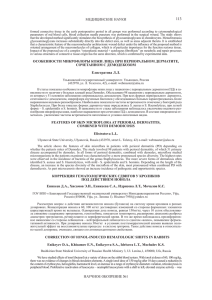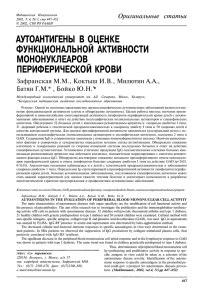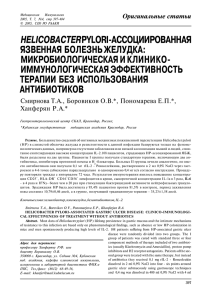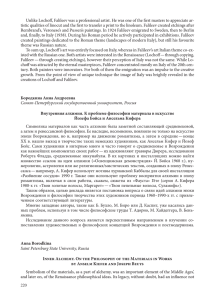Идея переноса столицы возникла как результат не столько
реклама
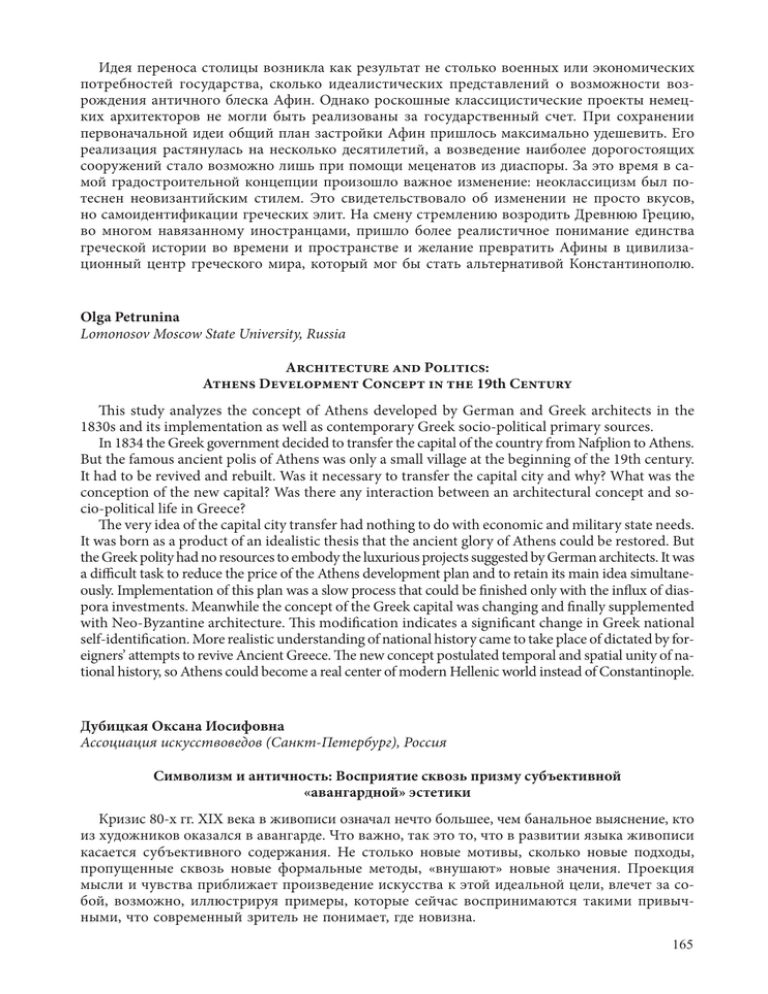
Идея переноса столицы возникла как результат не столько военных или экономических потребностей государства, сколько идеалистических представлений о возможности возрождения античного блеска Афин. Однако роскошные классицистические проекты немецких архитекторов не могли быть реализованы за государственный счет. При сохранении первоначальной идеи общий план застройки Афин пришлось максимально удешевить. Его реализация растянулась на несколько десятилетий, а возведение наиболее дорогостоящих сооружений стало возможно лишь при помощи меценатов из диаспоры. За это время в самой градостроительной концепции произошло важное изменение: неоклассицизм был потеснен неовизантийским стилем. Это свидетельствовало об изменении не просто вкусов, но самоидентификации греческих элит. На смену стремлению возродить Древнюю Грецию, во многом навязанному иностранцами, пришло более реалистичное понимание единства греческой истории во времени и пространстве и желание превратить Афины в цивилизационный центр греческого мира, который мог бы стать альтернативой Константинополю. Olga Petrunina Lomonosov Moscow State University, Russia Architecture and Politics: Athens Development Concept in the 19th Century This study analyzes the concept of Athens developed by German and Greek architects in the 1830s and its implementation as well as contemporary Greek socio-political primary sources. In 1834 the Greek government decided to transfer the capital of the country from Nafplion to Athens. But the famous ancient polis of Athens was only a small village at the beginning of the 19th century. It had to be revived and rebuilt. Was it necessary to transfer the capital city and why? What was the conception of the new capital? Was there any interaction between an architectural concept and socio-political life in Greece? The very idea of the capital city transfer had nothing to do with economic and military state needs. It was born as a product of an idealistic thesis that the ancient glory of Athens could be restored. But the Greek polity had no resources to embody the luxurious projects suggested by German architects. It was a difficult task to reduce the price of the Athens development plan and to retain its main idea simultaneously. Implementation of this plan was a slow process that could be finished only with the influx of diaspora investments. Meanwhile the concept of the Greek capital was changing and finally supplemented with Neo-Byzantine architecture. This modification indicates a significant change in Greek national self-identification. More realistic understanding of national history came to take place of dictated by foreigners’ attempts to revive Ancient Greece. The new concept postulated temporal and spatial unity of national history, so Athens could become a real center of modern Hellenic world instead of Constantinople. Дубицкая Оксана Иосифовна Ассоциация искусствоведов (Санкт-Петербург), Россия Символизм и античность: Восприятие сквозь призму субъективной «авангардной» эстетики Кризис 80-х гг. XIX века в живописи означал нечто большее, чем банальное выяснение, кто из художников оказался в авангарде. Что важно, так это то, что в развитии языка живописи касается субъективного содержания. Не столько новые мотивы, сколько новые подходы, пропущенные сквозь новые формальные методы, «внушают» новые значения. Проекция мысли и чувства приближает произведение искусства к этой идеальной цели, влечет за собой, возможно, иллюстрируя примеры, которые сейчас воспринимаются такими привычными, что современный зритель не понимает, где новизна. 165 Творчество Пюви де Шаванна (1824–1898) находится у истоков символизма. Античные сюжеты («Орфей»), к которым обращается художник, связывали его с литераторами-символистами, а именно с поэтом Шарлем Леконтом де Лилем и критиком Теофилем Готье. «Священная роща» — ода античности. Начиная с Пюви, соединение аллегории с настроением в живописи символисты воспринимают с пониманием, выбирая наиболее конгениальное их собственным целям: уединенности и самоуглубленности личности. Они пришли к заключению, что прекрасно скомпонованный, с вычитанием второстепенных деталей, стиль был двойником их собственных идей синтетизма, и что за его редуктивными классическими идиллиями существует истинно символический смысл. Гюстав Моро (1826–1898) — почитатель искусства античности. Вопреки запутанной иконографии Моро, его произведения (или, напротив, благодаря эдакому ребусу), с тех пор, как послания могли быть прочитанными (и разгаданными вербально, в деталях), критики и литераторы стали воспринимать Моро так, как преподносил себя он сам. А именно: идеалистом, создателем «искусства духа, сердца и воображения», чья цель «посредством линии, арабеска и пластических возможностей воскресить мысль». Неуловимые отсылки Моро к легендам античности были отожествлены с легкостью оригинального восприятия, с различными «дорогами», ведущими от реалий к идеям: «Аполон и девять муз», «Юпитер и Семела», «Фаэтон», «Эдип и Сфинкс», «Орфей на могиле Эвридики». Для Моро, например, первоначальное значение слова «сфинкс» утеряно. И значило слово меньше, чем тайна жизни, приемлемая как материальная экзистенция (греховная, враждебная духу). Моро был увлечен теорией искусства, обозначенной в философском эссе М. Метерлинка. По сути, символистской. Да и символика цвета у Моро предвосхищала эксперименты абстракционистов. Моро и Пюви де Шаванн никогда не входили в объединения символистов, но были их кумирами. Oksana Dubitskaya The Association of Art Critics, Russia Symbolism and Antiquity: Perception through the Lens of Subjective “avant-garde” Aesthetics The crisis of the 80s of the 19th century in painting meant something more than just figuring out which of the artists were in the vanguard. Clearly what is vital is the fact that in the development of the language of painting refers to subjective content. Not so much new motives, new approaches, perceived through new formal methods, “inspire” new values. The projection of thoughts and feelings bring the artwork to this perfect goal, entails perhaps illustrating examples, which are now perceived as commonplace so that the modern viewer doesn’t understand where the novelty is. The works of Puvis de Chavannes(1824–1898) are at the origins of symbolism. The ancient stories (“Orpheus”) the artist turned to linked him with the writers — symbolists, namely with the poet Charles Leconte de Lisle and critic Théophile Gautier. “Sacred grove” is an ode to antiquity. Since Puvis, the symbolists perceive with understanding the connection of allegory with the mood in painting, choosing the most congenial to their own purposes: privacy. They concluded that well-laid out, the style corresponded to their own ideas of synthetism, and that for its reductive classical idylls there is truly a symbolic meaning. Gustave Moreau (1826–1898) was also an admirer of the art of antiquity. Despite confusing iconography of Moreau, his writings (or, on the contrary, thanks to this rebus), since the message could be read (and solved verbally, in detail), critics and writers began to perceive 166 Moreau as he presented himself. Namely, the idealist, the creator of the “art of the spirit, heart and imagination” whose goal was “through line, arabesque and plastic possibilities to resurrect the idea”. Elusive references of Moreau to the legends of antiquity were equal with the easiness of original perception, with the various “paths” leading from reality to ideas: “Apollo and the nine muses”, “Jupiter and Semele”, “Phaeton”, “Oedipus and the Sphinx”, “Orpheus at the tomb of Eurydice”. For Moreau, for example, the original meaning of the word “Sphinx” is lost. The word meant less than the mystery of life which is accepted as a material existence (sinful, hostile to the spirit). Moreau was passionate about art theory outlined in philosophical essays by M. Maeterlinck. And Moreau’s symbolism of color anticipated the experiments of abstractionists. Moreau and Puvis de Chavannes were never members of the Association of the symbolists, but were their idols. Jerzy Malinowski Polish Institute of World Art Studies; Nicolaus Copernicus University of Torun, Poland Irina Gavrash, University of Gdansk, Poland Renaissance Inspirations in the Polish Paintings of the 19th and 20th Centuries The roots of the inspirations with the Renaissance painting in Polish art are related to the activities of the artistic colony in Rome formed around 1820. In the center of interest was mainly the work of Raphael, to which Wojciech Korneli Stattler referred when he created The Maccabees (1830–1842), the most important patriotic and symbolic painting of Polish Romanticism. In the next generation, Henryk Rodakowski alluded in historical scenes and portraits (e.g. Portrait of Leonia Bluhdorn) to the Venetian Renaissance (Titian and Veronese), creating an idealistic concept of beauty, expressed in the style defined as “a sense of grandeur combined with simplicity”. Jan Matejko chose a different way to hark back to the Renaissance, presenting “focal” moments of the Polish history in the 16th century (Prussian homage), symbolically reaching for the splendor of the forms of Venetian painting. A strong trend of the inspiration with the Renaissance developed around 1870 in the circle of the Polish colony in Munich. A mood of poetic dream, combined with the motifs of the Renaissance architecture and costumes appeared in the painting of Adam Chmielowski, whose attention was drawn to BÖcklin and Feuerbach (The Italian siesta). Similarly, with Aleksander Gierymski, the inspiration with Titian (in The Italian siesta) led to a new color structure of the painting, with an analogy to Impressionism. In the early 20th century, the work of classicizing artists like Eugeniusz Zak drew on Leonardo (portraits), Botticelli (idyllic scenes, like The Bather). Quattrocento appealed to Waclaw Borowski in the polychromy in the church in Miloslaw. These artists formed an interwar group “Rhythm”, which was the last major one to reveal links with the art of the Renaissance. One of its members was Ludomir Slendzinski, a graduate of the Academy of St. Petersburg, whose official propaganda works reflected the reference to the patterns of the early Renaissance and Roman motifs of that time. Ежи Малиновски Польский институт исследования мирового искусства; Торунский университет имени Николая Коперника, Польша Ирина Гавраш Гданьский университет, Польша Ренессансные мотивы в польской живописи XIX и XX веков Увлечение искусством Ренессанса среди польских художников было связано с деятельностью художественной колонии в Риме, сформировавшейся в 1820-е гг. Интерес вызывали 167

